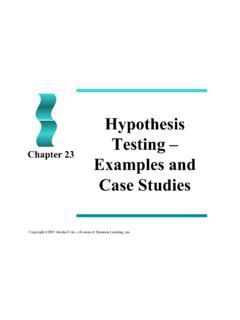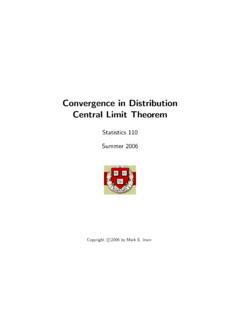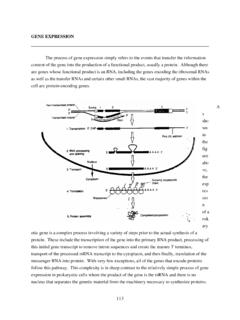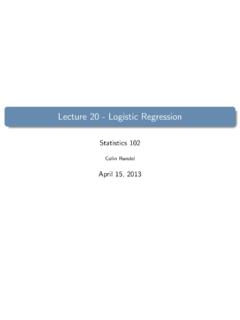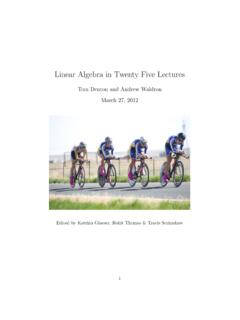Transcription of Multivariable Calculus - Duke University
1 Multivariable CalculusJerry ShurmanReed CollegeContentsPreface..ix1 Results from One-Variable Calculus .. The Real Number System .. Foundational and Basic Theorems .. Taylor s Theorem .. 6 Part I Multivariable Differential Calculus2 Euclidean Space.. algebra : Vectors .. Geometry: Length and Angle .. Analysis: Continuous Mappings .. Topology: Compact Sets and Continuity .. Review of the One-Variable Derivative .. Summary .. 603 linear Mappings and Their Matrices.. linear Mappings .. Operations on Matrices .. The Inverse of a linear Mapping .. Inhomogeneous linear Equations .. The Determinant: Characterizing Properties and TheirConsequences .. The Determinant: Uniqueness and Existence .. An Explicit Formula for the Inverse .. Geometry of the Determinant: Volume .. Geometry of the Determinant: Orientation.
2 The Cross Product, Lines, and Planes inR3.. Summary .. 130viContents4 The Derivative.. Trying to Extend the Symbol-Pattern: Immediate, IrreparableCatastrophe .. New Environment: the Bachmann Landau Notation .. One-Variable Revisionism; the Derivative Redefined .. Basic Results and the Chain Rule .. Calculating the Derivative .. Higher Order Derivatives .. Extreme Values .. Directional Derivatives and the Gradient .. Summary .. 1885 Inverse and Implicit Functions.. Preliminaries.. The Inverse Function Theorem .. The Implicit Function Theorem .. Lagrange Multipliers: Geometric Motivation and SpecificExamples.. Lagrange Multipliers: Analytic Proof and General Examples .. Summary .. 238 Part II Multivariable Integral Calculus6 Integration.. Machinery: Boxes, Partitions, and Sums .. Definition of the Integral.
3 Continuity and Integrability .. Integration of Functions of One Variable.. Integration Over Nonboxes .. Fubini s Theorem .. Change of Variable .. Topological Preliminaries for the Change of Variable Theorem Proof of the Change of Variable Theorem .. Summary .. 3287 Approximation by Smooth Functions.. Spaces of Functions .. Pulse Functions .. Convolution .. Test Approximate Identity and Convolution .. Known-Integrable Functions .. Summary .. 354 Contentsvii8 Parametrized Curves.. Euclidean Constructions and Two Curves.. Parametrized Curves .. Parametrization by Arc Length .. Plane Curves: Curvature .. Space Curves: Curvature and Torsion .. General Frenet Frames and Curvatures .. Summary .. 3889 Integration of Differential Forms.. Integration of Functions Over Surfaces.
4 Flow and Flux Integrals .. Differential Forms Syntactically and Operationally .. Examples: 1-forms .. Examples: 2-forms onR3.. algebra of Forms: Basic Properties .. algebra of Forms: Multiplication .. algebra of Forms: Differentiation .. algebra of Forms: the Pullback .. Change of Variable for Differential Forms .. Closed Forms, Exact Forms, and Homotopy .. Cubes and Chains .. Geometry of Chains: the Boundary Operator.. The General Fundamental Theorem of Integral Calculus .. Classical Change of Variable Revisited .. The Classical Theorems .. Divergence and Curl in Polar Coordinates .. Summary .. 481 Index..483 PrefaceThis is the text for a two-semester Multivariable Calculus course. The setting isn-dimensional Euclidean space, with the material on differentiation culminat-ing in the Inverse Function Theorem and its consequences, and the materialon integration culminating in the Generalized FundamentalTheorem of Inte-gral Calculus (often called Stokes s Theorem) and some of its consequences inturn.
5 The prerequisite is a proof-based course in one-variable Calculus . Somefamiliarity with the complex number system and complex mappings is occa-sionally assumed as well, but the reader can get by without book s aim is to use Multivariable Calculus to teach mathematics asa blend of reasoning, computing, and problem-solving, doing justice to thestructure, the details, and the scope of the ideas. To this end, I have triedto write in a style that communicates intent early in the discussion of eachtopic rather than proceeding coyly from opaque , I have triedoccasionally to speak to the pedagogy of mathematics and itseffect on theprocess of learning the subject. Most importantly, I have tried to spread theweight of exposition among figures, formulas, and words. Thepremise is thatthe reader is ready to do mathematics resourcefully by marshaling the skillsof geometric intuition (the visual cortex being quickly instinctive), algebraic manipulation (symbol-patterns being precise and robust), and incisive use of natural language (slogans that encapsulate central ideasenabling a large-scale grasp of the subject).
6 Thinking in these ways renders mathematics coherent, inevitable, and my own student days I learned this material from books by Apostol,Buck, Rudin, and Spivak, books that thrilled me. My debt to those sourcespervades these pages. There are many other fine books on the subject as well,such as the more recent one by Hubbard and Hubbard. Indeed, nothing inthis book is claimed as new, not even its neuroses. Whatever improvementthe exposition here has come to show over the years is due to innumerableideas and comments from my students in way of a warm-up, chapter 1 reviews some ideas from one-variablecalculus, and then covers the one-variable Taylor s Theorem in 2 and 3 cover what might be called Multivariable pre- Calculus , in-troducing the requisite algebra , geometry, analysis, and topology of Euclideanspace, and the requisite linear algebra , for the Calculus tofollow.
7 A pedagogicaltheme of these chapters is that mathematical objects can be better understoodfrom their characterizations than from their constructions. Vector geometryfollows from the intrinsic (coordinate-free) algebraic properties of the vectorinner product, with no reference to the inner product formula. The fact thatpassing a closed and bounded subset of Euclidean space through a continuousmapping gives another such set is clear once such sets are characterized interms of sequences. The multiplicativity of the determinant and the fact thatthe determinant indicates whether a linear mapping is invertible are conse-quences of the determinant s characterizing properties. The geometry of thecross product follows from its intrinsic algebraic characterization. Further-more, the only possible formula for the (suitably normalized) inner product,or for the determinant, or for the cross product, is dictatedby the relevantproperties.
8 As far as the theory is concerned, the only role of the formula isto show that an object with the desired properties exists at all. The intenthere is that the student who is introduced to mathematical objects via theircharacterizations will see quickly how the objects work, and that how theywork makes their constructions the same vein, chapter 4 characterizes the multivariablederivative as awell approximating linear mapping. The chapter then solvessome multivari-able problems that have one-variable counterparts. Specifically, the multivari-able chain rule helps with change of variable in partial differential equations,a Multivariable analogue of the max/min test helps with optimization, andthe Multivariable derivative of a scalar-valued function helps to find tangentplanes and 5 uses the results of the three chapters preceding itto prove theInverse Function Theorem, then the Implicit Function Theorem as a corollary,and finally the Lagrange Multiplier Criterion as a consequence of the ImplicitFunction Theorem.
9 Lagrange multipliers help with a type of multivariableoptimization problem that has no one-variable analogue, optimization withconstraints. For example, given two curves in space, what pair of points one on each curve is closest to each other? Not only does thisproblem havesix variables (the three coordinates of each point), but furthermore they arenot fully independent: the first three variables must specify a point on thefirst curve, and similarly for the second three. In this problem,x1throughx6vary though a subset of six-dimensional space, conceptually a two-dimensionalsubset (one degree of freedom for each curve) that is bendingaround in theambient six dimensions, and we seek points of this subset where a certainfunction ofx1throughx6is optimized. That is, optimization with constraintscan be viewed as a beginning example of Calculus on curved another example, letnbe a positive integer, and lete1.
10 ,enbepositive numbers withe1+ +en= 1. Maximize the functionf(x1,..,xn) =xe11 xenn, xi 0 for alli,subject to the constraint thate1x1+ +enxn= in the previous paragraph, since this problem involves one condition onthe variablesx1throughxn, it can be viewed as optimizing over an (n 1)-dimensional space insidendimensions. The problem may appear unmotivated,but its solution leads quickly to a generalization of the arithmetic-geometricmean inequality ab (a+b)/2 for all nonnegativeaandb,ae11 aenn e1a1+ +enanfor all nonnegativea1,.., to integral Calculus , chapter 6 introduces the integral of a scalar-valued function of many variables, taken over a domain of itsinputs. When thedomain is a box, the definitions and the basic results are essentially the same asfor one variable. However, in Multivariable Calculus we want to integrate overregions other than boxes, and ensuring that we can do so takesa little this is done, the chapter proceeds to two main tools formultivariableintegration, Fubini s Theorem and the Change of Variable Theorem.



